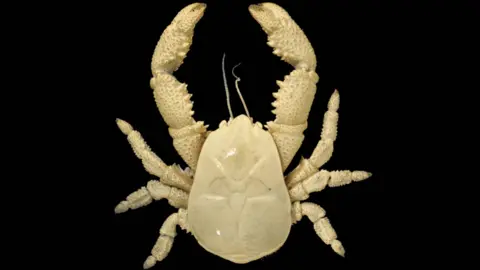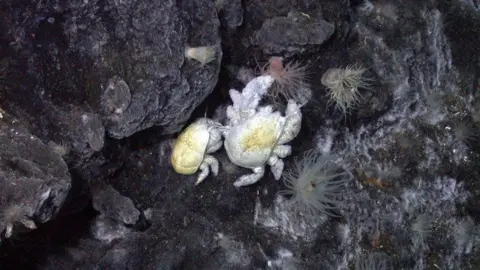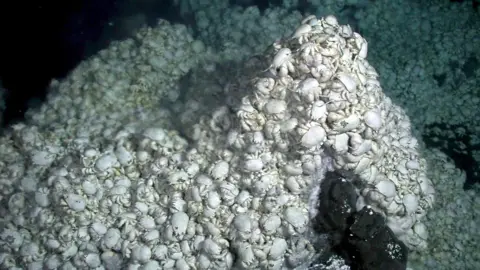Hasselhoff crab has bigger claws to fight for mate
 Getty Images
Getty ImagesMale crabs of a species named after actor David Hasselhoff grow bigger claws than females so they can fight each other for a mate, according to a new study.
Scientists from the universities of Portsmouth and Southampton discovered the difference in claw size while monitoring "The Hoff" crabs.
The species gained its nickname thanks to its hairy chest, prompting comparisons to the Baywatch star.
It lives in large communities around hot vents on the seafloor in Antarctica, with its many hairs hosting bacteria - which the crab feeds on.
 University of Portsmouth
University of PortsmouthThe latest study examined 135 of the crabs - part of the Kiwaidae family which are also known as Yeti crabs because of their bristly appearance - at the East Scotia Ridge in the Scotia Sea.
Dr Nicolai Roterman, a deep-sea ecologist from the University of Portsmouth and lead author of the study, said: "Knowing that there's a difference in size between the male and female claws helps us understand the behaviour and ecology of the yeti crab family - which we know little about because they are a fairly recent discovery, and their home is very difficult to reach.
"Physical differences between males and females is a common feature of decapod crustaceans which live in shallow water, and usually it's because the male is forced to guard the mate, or females have to divert their growth energy for reproduction."
 University of Portsmouth
University of PortsmouthThe team compared The Hoff crab with another yeti crab found off Costa Rica, which does not show difference claw sizes between the sexes.
The difference could be because the Costa Rican crabs use their claws - which are longer and hairier than those of the Hoff crab - mostly for making food rather than fighting, Dr Roterman said.
"We don't yet know if these claw sex differences are the norm for the yeti crab family, or an exception, but the discovery provides a starting point for future research" he said
 University of Portsmouth
University of PortsmouthDr Roterman, who coined the Hoff nickname when the species was first discovered in 2010, added: "Understanding the physiology, behaviour, ecology and evolution of animals adapted to the most extreme conditions give us insights into what evolution is capable of, and therefore how life is likely to adapt to a warming planet and other natural and human-induced ecological stressors."
You can follow BBC Hampshire & Isle of Wight on Facebook, X, or Instagram.
